Top News
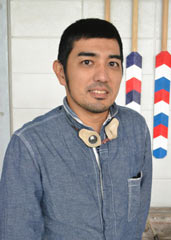
January 4, 2013 Ryukyu Shimpo
In mid-February, Hiroyasu Tamaki will open an Itoman fishermen’s style diner in Nishizaki. The restaurant will reflect traditional Itoman uminchu (fishermen) culture, and will use fresh fish caught in the sea off Itoman. A feature of the menu is going to be a modern version of a traditional meal fish soup that uminchu used to eat every day. Tamaki said, “We want to provide newly arranged traditional local cuisine and increase awareness of fish in Itoman. Tamaki’s parents’ family business is the fish wholesaler, Sho-Reito Co., and he helped them when he was a child. They took him to the fish market, and so he became familiar with fish.
After he graduated university, he became a bank clerk. He then opened an izakaya or Japanese style tavern in Naha. Just when he was thinking of opening another izakaya in Itoman, he read the book Fishermen of Okinawa – the life and times of Itoman uminchu by Hisako Kato. He found his grandmother’s name in the book and felt a connection through this. Because he was thinking of opening another izakaya in Itoman, the book encouraged him to go ahead with the idea. He visited Ken Uehara, the manager of Itoman Uminchu Studio Resource Center and learned about traditional uminchu cooking. Tamaki said, “I want to let people know about local cuisine, which was enjoyed by the Itoman uminchu. By playing around with the approach to cooking and seasoning, I would like people to know more about delicious Okinawa fish dishes.”
(English translation by T&CT, Hitomi Shinzato and Mark Ealey)
Go to Japanese
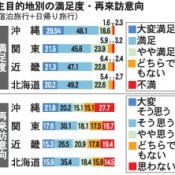
January 9, 2013 Ayako Sakaguchi of Ryukyu Shimpo
On January 7, the Japan Tourism Agency released results of a survey of travel and tourism trends such as satisfaction and intention to re-visit. According to the survey, focusing on those who traveled to domestic tourist spots, Okinawa accounted for 29.5 percent of the people who answered “very satisfied,” which is the highest percentage of the ten regions nationwide. While the tourists who answered that “I definitely think so,” to the question of whether you will visit Okinawa again within one year was 21.8 percent of the total, which is the highest by region, the percentage of visitors who answered “I do not think so,” was 27.7 percent, which is also the highest among the regions. Some experts speculate that expensive air-transport costs and the long distance compared to the other regions, is behind the high-rate of the people who say they do not want to re-visit.
Okinawa scored 96.2 percent, which is the largest portion of the people who answered that they were “satisfied,” followed by Kanto (21.5 percent), Kinki (21.3 percent), Hokkaido (20.2 percent) and Shikoku with the lowest percentage of 10.5.
Yoshihiro Sugimoto, the general manager of the Naha Branch of the Bank of Japan, commented, “The survey is a good result for Okinawa in terms of the very high level of satisfaction. However, the problem remains that there is a marked difference between satisfaction in the first visit and the intention to visit again, and that the two are not linked. It is important to increase the repeater rate, and not to rely on one-stay type tourists.”
Yoshiro Shimoji, the deputy director general in charge of tourism in the Okinawa Prefectural Government, said, “It could be the effect of the season when tourists cannot enjoy the sea or due to bad weather. We should not read too much into the survey results because tourists all have different needs and perceptions.”
The survey was carried out by distributing the questionnaire to about 50000 people chosen at random nationwide. The Japan Tourism Agency collated the results from the 24491 responses during the period from January until June 2012. Of the respondents, 150 people had visited Okinawa very recently.
(English translation by T&CT, Mark Ealey)
Go to Japanese
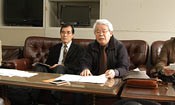
January 11, 2013 Ryukyu Shimpo
On January 11, at the Press Club in the Okinawa Prefectural Government office, Teruo Hiyane, professor emeritus of the University of the Ryukyus, Ishihara Masaie, professor emeritus of the Okinawa International University and other prominent intellectuals held an emergency press conference. They asserted that the governments of Japan, China and Taiwan should avoid making the Senkaku Islands dispute the cause of military tension, and that these nations should share the islands in the spirit of coexistence and cooperation. They announced a plan to launch an organization early this year in which intellectuals based in the prefecture will make policy proposals on issues related to Okinawa, including the Senkaku Islands dispute. They aim to get 100 people to take part in the organization.
Kenichi Uezato, professor emeritus of the University of the Ryukyus, Tetsumi Takara and Ikuo Shinjo, both professors at the University of the Ryukyus, Hiroshi Nakachi, professor at Okinawa University and Satoshi Gabe, a lecturer at the Okinawa University and Hiroyuki Teruya, professor at Okinawa International University, put their names to the statements.
In the statements, they pointed out that the Senkaku Islands used to be part of the living environment of the fishermen of Sakishima Islands and Taiwan, and were not disputed islands before the establishment of modern nation states. Okinawan intellectuals stated that Chinese patrol ships entering waters around the islands has caused tension between Japan and China, and that the issue was used as an excuses by the U.S. and Japanese governments to deploy the Osprey aircraft to Okinawa and the Self-Defense Forces to the Sakishima Islands, and that these acts are unacceptable to local citizens. They asserted that the Chinese government should cease such provocative acts, and that the Japanese government should not reinforce the level of Self-Defense Forces in the Sakishima Islands on the pretext of defending the Senkaku Islands.
In the statements, they asserted that the governments of Japan, China and Taiwan should make the islands into a demilitarized zone, seeing them as a symbol of coexistence, cooperation and friendship, holding academic discussions about historical issues among the countries, and establishing a consultative organization to prevent incidents from occurring within waters around the islands. They will send the written statement to organizations related to the governments of China and Taiwan in Japan and to the U.S. Consulate in Naha.
In the organization that will be established this year, they plan to hold academic discussions and lecture meetings. They also aim to launch the project so as to inherit the spirit of the One-foot Film Movement, an organization of Okinawan locals that purchased the Battle of Okinawa footage filmed by the U.S. military, that is scheduled to cease operations in March.
At the press conference, Hiyane said, “The Japanese government’s nationalization of the Senkaku Islands is an act that strongly evokes feelings of territorial nationalism between Japan and China. As those who experienced the Battle of Okinawa, we sense that the dispute could lead to something akin to that conflict.”
(English translation by T&CT, Mark Ealey)
Go to Japanese
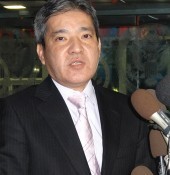
January 13, 2013 Hideki Matsudo of Ryukyu Shimpo reports from Washington D.C.
In a press conference held in the Department of Defense on January 11, Michael Donley, secretary of the United States Air Force, has commented on the plan to deploy the CV-22 Osprey, an air-force variant of the MV-22 Osprey vertical take-off and landing transport aircraft, to the main islands of Japan, and to Okinawa.
Although U.S. officials avoided giving specific details of the deployment such as locations and dates, the expectation is that the U.S. military will start to deploy about 10 of the CV-22 Osprey aircraft to the U.S. Air Force’s Kadena base in Okinawa in about two years, and then complete the deployment within several years.
Susumu Matayoshi, the head of the Executive Office of the Governor, who is now visiting Washington, met Christopher Johnstone, the Pentagon director for Northeast Asia to seek confirmation of the plan. Johnstone said that the United States is considering the deployment, but that it is not written in stone. Matayoshi talked to the press after his meeting with Johnstone, saying, “The Okinawa Prefectural Government cannot allow the deployment because there are concerns among the Okinawan people about the safety of the Osprey.”
Asked whether or not the U.S. military plans to deploy the CV-22 Osprey to Okinawa or other parts of Japan, Michael Donley, secretary of the U.S. Air Force, suggested that the Pentagon is considering that option. While Donley said that he would prefer not to comment on potential locations, he did confirm the plan for deployment.
After his press conference, a spokesperson for the Department of Defense then modified what Donley had stated, saying that while the U.S. military does plan to deploy the CV-22 in the Asia-Pacific region within several years, the construction of facilities to host the aircraft has not started. The spokesperson went on to say that the plan is not set in concrete, and that the U.S. government has not notified the Japanese government about it.
(English translation by T&CT, Mark Ealey)
Go to Japanese
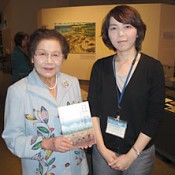
December 25, 2012, Michiyo Kuniyoshi of Ryukyu Shimpo
The Himeyuri Peace Museum has published a new book entitled Himeyuri Students who survived — the path home from the internment camp. At the museum, the Himeyuri stories in the exhibitions or in printed materials are mainly focused on what happened during the battle, which for them was from March 23 in 1945 when the Himeyuri students were mobilized to the Japanese army hospital, until June 18 when the dissolution order was given. The new publication provides readers with a different focus on their lives after survival in the internment camp until they were reunited with their families. The director of the museum, Yoshiko Shimabukuro says, “After they were captured, the students were constantly thinking about their lost friends. We would like to let the younger generation know what it was like after surviving, that the students were struggling and suffered from invisible wounds.”
The new book consists of the personal notes of 24 students. They are divided into two categories: “The path from the internment camp to home,” and “Looking for the remains of friends.” The book was edited to be easy to read, and includes some notes written by the museum curators as well as some old pictures.
Hisa Tsuhako wrote about her experience of being captured after the dissolution order and taking care of orphans at Hyakuna in Tamagusuku. Her story explains how when a typhoon hit Okinawa after the war, children thought that the war had started over again, and she had to carry them and find shelter while they were crying out their parents for help.
Fumiko Higa wrote about finding the remains of her friends at Odo beach in Itoman. She wrote about a heartrending scene in which bereaved families collected stones instead of bones, placing them in an urn and talking to them, saying, “Let’s go home,” as though they were their lost family members.
At the museum, the exhibition Himeyuri Students who Survived will continue until March 31 next year. A guide at the museum, Akiko Nakada says, “We thought that it would be important to tell the untold stories about students’ lives after the war and about the period until this museum was created.” The book can be purchased at the museum for 1500 yen.
(English translation by T&CT, Kyoko Tadaoka and Mark Ealey)
Go to Japanese
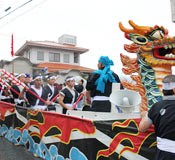
January 5, 2013 Ryukyu Shimpo
On January 3, at the Kowan in Urasoe, the traditional Agibari Michijune parade was held to pray for the health and prosperity of the local people. Men from Kowan stood on floats shaped like dragon boats as they paraded about one kilometer through the village in the pouring rain, sounding a gong or shouting as they went.
The Kowan Agibari started during the celebrations for the coronation of the Emperor Taisho in 1915, similar to the Jibari of the Tomari district in Naha.
By adding its own distinctive style to Tomari’s Jibari, Kowan’s Agibari has been handed down as an event unique to the district. It was discontinued for a time, but was revived in the late 1970s. The event is held on January 3 as a New Year festival, and this year was the seventh time that it has been held.
After prayers in the community cemetery, the participants were divided into two groups – rowers, or bell-ringing men and flag-bearers, who then paraded to Omiya Park, pulling floats with people on board. During the parade, they sang the Agibari song and performed the hand actions and gestures of rowing the boat. The gae performance was held with the standard-bearer of the rival Iso district, as were other shows such as guyamachi.
Gisei Gibo, who watched the parade, said, “I think that we greeted the New Year with Agibari. I am really happy to see young people working to inherit this traditional event. I hope that they will continue the parade into the future.” He smiled as he held up a sacred sake glass.
(English translation by T&CT, Mark Ealey)
Go to Japanese
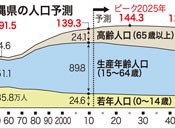
January 1, 2013 Yoko Shima of the Ryukyu Shimpo
The Okinawa Prefectural Government (OPG) is putting together an Okinawa population growth plan for fiscal year 2013. It estimates that the population of the prefecture will peak in 2025, before then starting to decline. The OPG wants to avert this trend, and to increase the population that is the lifeblood of Okinawa. It hopes to use subsidies from the central government to increase the population of 1.4 million to 1.5 million people, implementing a range of measures, including parenting support to increase the number of births, encouraging population transfer such as U-turn and preventing population spills from remote islands and depopulated areas. They are considering adding this project to the Okinawa Vision for the 21st Century, a new promotion plan for the prefecture.
Okinawa Governor Hirokazu Nakaima said, “Region where the population decreases will rapidly fall behind. It is important for the promotion of Okinawa that we will strive to take measures not only to prevent population decrease, but also continue to increase our population.” He suggested that as model areas, they would take measures on remote islands such as Kumejima where the population has decreased.
In other prefectures, there are many cases where local governments are working independently to get people to return and implementing measures to counter the falling birthrate. However, the comprehensive approach towards population growth that the OPG is carrying out will be an exceptional case.
Some experts claim that Japan’s population began to decline from 2005. As of October 2011 the total population of Japan was 127.79 million. It is estimated to fall below 100 million people in around the year 2050, and 40 percent of the population will be 65 years old or older in around 2060. In a survey conducted by the Ministry of Internal Affairs and Communications in 2011, population decline was studied in 40 prefectures. Okinawa had the highest rate of increase among the seven prefectures that displayed population increases, an increase of 0.59 percent over the previous year. However, due to its decline in the birth rate, the population of Okinawa also will begin to decline once it has peaked at 1.44 million. The working-age population of 15-64 years, which have higher employment rates, will decrease beyond 2015. The decrease in the number of workers will see a decrease in the gross prefectural domestic product and per capita gross prefectural income.
If we see the population as 100 in 1975, while the populations in the southern districts of the main island of Okinawa and Yaeyama have grown, those in Miyako, the Kerama Islands, and Kume-jima have decreased. The OPG is developing a plan focusing on the following five pillars: creating an easy environment in which to give birth to and raise children, longevity health measures, U-, I- and J-turn promotion projects, depopulation measures in remote islands and increasing the number of inbound tourists.
(English translation by T&CT, Mark Ealey)
Go to Japanese
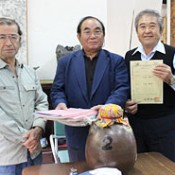
December 25, 2012, Ryukyu Shimpo
In Nago, Kanemasa Kuba, a counselor a social welfare organization and Yoshiaki Matayoshi, an instructor of the Okinawa Labor Standards Association have invented and registered an awamori maturation device. It is a stand that holds an awamori jar and vibrates to accelerate maturation and to create a taste similar to kusu or aged awamori in a relatively short time.
The sales point of the device is that it makes young awamori taste milder. Kanemasa Kuba said, “It is easy to use and can be used in home. We want consumers to use it at home, not for business.”
On October 17, they received the registration certificate from the Commissioner of Patents. An awamori jar is placed on the stand, and a monitor is placed under the stand, which is a few dozen centimeters in height and width. Between the stand and its base, there is a timer to turn the spring that spins 1800 times per minute, on and off, but the vibration is very delicate and hard to perceive.
Friend of Kanemasa Kuba, welder Yoshiaki Matayoshi made the stand, and Takaaki Nakasone from Kogachi Pottery made the awamori jar.
They brought the awamori stored on the maturation device for a year to a public agency and requested a test. Compared to the original awamori, it had increased its level of sodium and magnesium, and its taste was close to that of five year-old awamori.
Kanemasa Kuba said, “I got the idea from a story about awamori transported to China during the Ryukyu dynasty. By the time it arrived in China the taste was much milder. We replicated that artificially.”
Please contact Kanemasa Kuba at 090 3011-4246 if you are interested in the equipment.
(English translation by T&CT, Hitomi Shinzato and Mark Ealey)
Go to Japanese

December 31, 2013 Ryukyu Shimpo
On around January 10, Susumu Matayoshi, the head of the Executive Office of the Governor, visited Washington to directly convey to U.S. government officials that the prefectural government would continue to demand the relocation of U.S. Marine Corps Futenma Air Station outside of Okinawa. Matayoshi intends to reassert the prefectural government’s position regarding the plan ahead of President Barack Obama’s inauguration for his second term on January 21. Prime Minister Shinzo Abe is scheduled to hold summit talks with Obama around the time of the inauguration.
Because Prime Minister Abe intends to uphold the bilateral pact to relocate the Futenma Air Station to the Henoko district of Nago, before the summit meeting with President Obama occurs, Matayoshi aims to convey to the U.S. government that the people of Okinawa are not swayed, and to demand the relocation of the base outside of the prefecture. Matayoshi intends to meet with Marc Knapper, director of the Office of Japanese Affairs at the State Department and Christopher Johnstone, the Pentagon director for Northeast Asia.
In addition to the Futenma relocation issue, Okinawa senior official Matayoshi will explain to the U.S. government officials the strong feelings on Okinawa about ongoing crimes and incidents involving U.S. military personnel. He intends to meet researchers who have some degree of influence over the U.S. administration.
Given that a new defense secretary and secretary of state will be appointed for Obama’s second term, Matayoshi intends to give detail of the prefectural government’s stance to the U.S. government, and to gather information about the Obama administration’s new strategic policy that emphasizes the Asia-Pacific region.
Last time Matayoshi visited Washington to oppose the deployment of the Osprey vertical take-off and landing transport aircraft to Okinawa in July 2012, he demanded the relocation of Futenma Air Station outside of Okinawa.
Last October, Okinawa Governor Hirokazu Nakaima met with Kurt Campbell, the assistant secretary of state for East Asian and Pacific affairs, and Mark Lippert, the assistant defense secretary for Asian and Pacific security affairs, in the State Department in Washington, D.C., and demanded the relocation of the base outside of the prefecture.
Matayoshi intends to explain during his meetings that despite the launch of the new Abe-led government Nakaima still asserts that the base should be relocated outside Okinawa. He will also tell U.S. officials that all four Liberal Democratic Party’s lawmakers from Okinawa who won parliamentary seats in the latest general election, also seek relocation of the base outside the prefecture, and that there is strong opposition to the Henoko plan among the Okinawan people.
(English translation by T&CT, Mark Ealey)
Go to Japanese

December 26, 2012 Ryukyu Shimpo
On December 25, at Naha Airport, an unveiling ceremony was held for an airplane featuring a whale shark design for Japan TransOcean Air (JTA). It was a tie-up event marking the tenth anniversary of the opening of the Okinawa Churaumi Aquarium and the 45th anniversary of JTA’s foundation. The aircraft will be used for five years. Ahead of its maiden flight on December 26, 40 children from Motobu were invited to enjoy a sightseeing flight.
The design of the airplane was based on a whale shark named Jinta from Churaumi Aquarium. The company hopes that just as Jinta swims in the sea, the airplane flying freely in the sky will conjure up the image of Okinawa. Hikaru Ogido, a fifth-grade pupil of Izumi Elementary School in Motobu said, “It’s just like the whale shark I saw at Churaumi Aquarium. I’m looking forward to seeing it flying up in the blue sky.”
(English translation by T&CT, Lima Tokumori and Mark Ealey)
Go to Japanese

Go To Video

December 27, 2012 Kenta Tokumoto of Ryukyu Shimpo
On December 26, 87 year-old Zenjin Onaha, who served as an announcer for Hogen News or Okinawan dialect news for Radio Okinawa for 30 years, brought his career to an end. Hoping to promote Uchinaguchi to the public, Onaha used to read the news in Uchinaguchi that he had translated from Japanese. Many young people are not familiar with Uchinaguchi, but there is increasing activity to revitalize the local dialect. Onaha now passes on to the next generation his strong desire to keep Uchinaguchi alive.
Hogen News is broadcast at 1:00pm for five minutes in a program called Tisaji Paradise, which is hosted by Hipu (Jin Maehira).
Onaha has decided to hand over his slot to a successor to Kazuo Uechi, a project coordinator of the National Theatre Okinawa. Onaha is the first son of the late Buten (Zenko) Onaha who helped to cheer up post-war Okinawan people with his humor. While Onaha humbly says, “I am nothing in comparison to my father,” he has often displayed his sense of humor in his interaction with Hipu.
Onaha looked back his 30 years saying, “I am sure that Uchinaguchi contributes to Okinawan arts and culture. I have always tried to translate things into in comprehensible Uchinaguchi for young people.”
In his last broadcast, on December 26, he received many messages from listeners who had enjoyed Onaha’s calm and well-pronounced Uchinaguchi through the years. He said, “I am very happy, and will continue to promote the use of Uchinaguchi.”
(English translation by T&CT, Megumi Chibana and Mark Ealey)
Go to Japanese












 Webcam(Kokusai Street)
Webcam(Kokusai Street)


